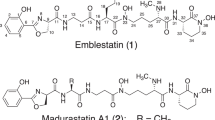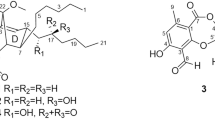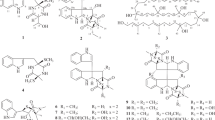Abstract
Bhatnagar and Divekar1 described the isolation of an antibiotic, an orange-coloured pigment which they called ‘pristimerin’, from Pristimerae indica and P. grahami (Celastraceae). They found that this compound is particularly active against the viridans group of streptococci. We have been studying the constitution of this complex molecule.
This is a preview of subscription content, access via your institution
Access options
Subscribe to this journal
Receive 51 print issues and online access
$199.00 per year
only $3.90 per issue
Buy this article
- Purchase on Springer Link
- Instant access to full article PDF
Prices may be subject to local taxes which are calculated during checkout
Similar content being viewed by others
References
Bhatnagar and Divekar, J. Sci. Indust. Res., 10 B, 56 (1951).
Karrer and co-workers, Helv. Chim. Acta, 33, 803, 812 (1950). Feiser, J. Amer. Chem. Soc., 48, 2925 (1926).
Gisvold, J. Amer. Pharm. Soc., 28, 449 (1939); 29, 12 (1940); 31, 529 (1942). Feiser and Jones, J. Amer. Pharm. Soc., 31, 315 (1942). Schechter and Haller, J. Amer. Chem. Soc., 64, 182 (1942).
Author information
Authors and Affiliations
Rights and permissions
About this article
Cite this article
KULKARNI, A., SHAH, R. Structure of Pristimerin. Nature 173, 1237–1238 (1954). https://doi.org/10.1038/1731237b0
Issue Date:
DOI: https://doi.org/10.1038/1731237b0
Comments
By submitting a comment you agree to abide by our Terms and Community Guidelines. If you find something abusive or that does not comply with our terms or guidelines please flag it as inappropriate.



